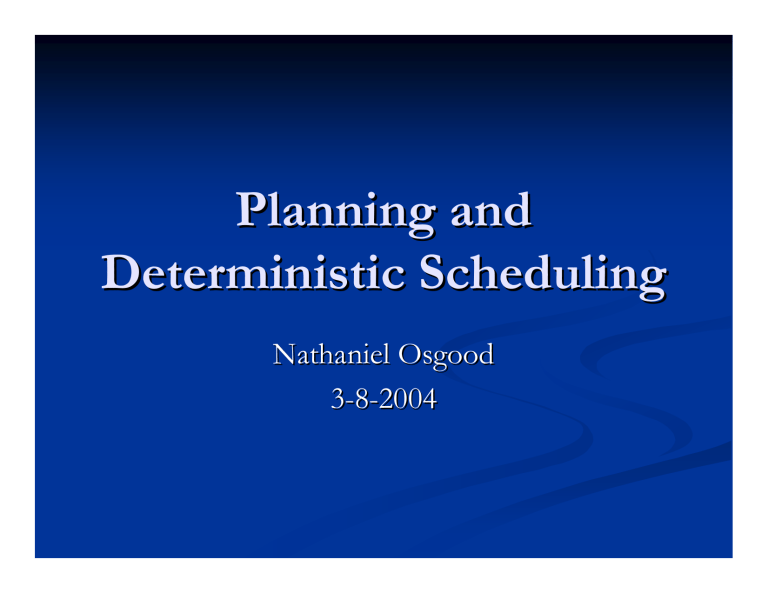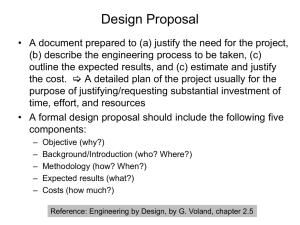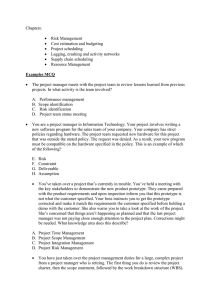Planning and Deterministic Scheduling Nathaniel Osgood 3
advertisement

Planning and
Deterministic Scheduling
Nathaniel Osgood
3-8-2004
Topics
Problem set background
Planning
CBS
OBS
WBS
Scheduling
Motivations and context
Gantt charts
CPM
Float
Critical path
Float ownership
A Word on the Problem Set
Construction methods
Assume tie-backs required to support structure during
construction (need invert slab formwork)
Slab on grade
Casting using invert forms
Not responsible for slab on grade
Can cast beams and slabs at same time
Wall casting (illustration only)
Don’t worry about formwork reuse
Several types of anchor bolts in structure
Casting a concrete slab on grade
Sequence:
1.
2.
3.
4.
5.
6.
7.
(You are not responsible for this formwork in the assignment)
Form and edges
Reinforcement and
embedment
Striking off or
straightedge
Floating (if
smoother surface
is needed)
Control joints
Troweling (if very
smooth surface is
needed)
Curing (under
damp conditions)
Casting a concrete wall
Sequence:
1.
2.
3.
4.
5.
6.
7.
8.
9.
10.
11.
Coated form (one side
only)
Reinforcing
Placement of Ties
Placement of construction
joints (if needed)
Inspection
Coated form (2nd side)
Placing concrete
Curing
Stripping of formwork and
snapping off ties
Point and Patch
Rub
Planning Components
What: Scope (Plans and specifications)
How much $: Budget (via CBS – and estimate)
Who: OBS
How: WBS
When: Schedule
Topics
9
Problem set background
Planning
CBS
OBS
WBS
Scheduling
Motivations and context
Gantt charts
CPM
Float
Critical path
Float ownership
Cost Breakdown Structure (CBS)
Canonical way of accounting for costs in the
project
Assigns accounts for different types of
expenditures
Should permits tracking expenditure by activity
(work item)
Often includes WBS-based characterization (e.g.
CSI Masterformat)
CSI Masterformat (Building Const)
Bidding Requirements, Contract Forms,
and Conditions of the Contract
00010 Pre-bid Information
00100 Instructions to Bidders
00200 Information available to Bidders
00300 Bid Forms
00400 Supplements to Bid Forms
00500 Agreement Forms
00600 Bonds and Certificates
00700 General Conditions
00800 Supplementary Conditions
00900 Addenda
Note: The items listed above are not specification sections
and are referred to as "Documents" rather than "Sections"
in the Master List of Section Titles, Numbers, and
Broadscope Section Explanations.
Specifications
Division 1 - General Requirements
01010
01020
01025
01030
01035
01040
01050
01060
01070
01090
01100
01200
01300
01400
01500
01600
01650
01700
01800
Summary of Work
Allowances
Measurement and Payment
Alternates/Alternatives
Modification Procedures
Coordination
Field engineering
Regulatory Requirements
Identification systems
References
Special Project Procedures
Project Meetings
Submittals
Quality Control
Construction Facilities and Temporary Controls
Material and Equipment
Facility Startup/Commissioning
Contract Closeout
Maintenance
Division 2 - Site Work
02010
02050
02100
02140
Subsurface Investigation
Demolition
Site Preparation
Dewatering
02150
02160
02170
02200
02300
02350
02450
02480
02500
02600
02660
02680
02700
02760
02770
02780
02800
02900
Shoring and Underpinning
Excavation Support Systems
Cofferdams
Earthwork
Tunneling
Piles and Caissons
Railroad Work
Marine Work
Paving and Surfacing
Utility Piping Materials
Water Distribution
Fuel and Steam Distribution
Sewerage and Drainage
Restoration of Underground Pipe
Ponds and Reservoirs
Power and Communications
Site Improvements
Landscaping
Division 3 - Concrete
03100
03200
03250
03300
03370
03400
03500
03600
03700
03800
Concrete Framework
Concrete Reinforcement
Concrete Accessories
Cast-In-Place Concrete
Concrete Curing
Precast Concrete
Cementitious Decks and Toppings
Grout
Concrete Restoration and Cleaning
Mass Concrete
Division 4 - Masonry
04100
04150
04200
04400
04500
04550
04600
04700
Mortar and Masonry Grout
Masonry Accessories
Unit Masonry
Stone
Masonry Restoration and Cleaning
Refractories
Corrosion Resistant Masonry
Simulated Masonry
Division 5 - Metals
05010 Metal Materials
05030 Metal Coatings
05050
05100
05200
05300
05400
05500
05580
05700
05800
05900
Metal Fastening
Structural Metal Framing
Metal Joists
Metal Decking
Cold Formed Metal Framing
Metal Fabrications
Sheet Metal Fabrications
Ornamental Metal
Expansion Control
Hydraulic Structures
Division 6 - Wood and Plastics
06050
06100
06130
06150
06170
06200
06300
06400
06500
06600
06650
Fasteners and Adhesives
Rough Carpentry
Heavy Timber Construction
Wood and Metal Systems
Prefabricated Structural wood
Finish Carpentry
Wood Treatment
Architectural Woodwork
Structural Plastics
Plastic Fabrications
Solid Polymer Fabrications
Division 7 - Thermal and Moisture Protection
07100
07150
07180
07190
07195
07200
07240
07250
07270
07300
07400
07480
07500
07570
07600
07700
07780
07790
Waterproofing
Damproofing
Water Repellents
Vapor Retarders
Air Barriers
Insulation
Exterior Insulation and Finish Systems
Fireproofing
Firestopping
Shingles and Roofing Tiles
Manufactured Roofing and Siding
Exterior Wall Assemblies
Membrane Roofing
Traffic Coatings
Flashing and Sheet Metal
Roof Special Ties and Accessories
Skylights
Joint Sealers
Cost Code
Mirrored by cost hierarchy
Commonly include standardized and project
components
Project id (often has useful info to avoid lookup)
Often omitted from internal project references
Area-facility code (geographically distributed
projects, or areas of a facility unique to project)
Work-type code: WBS May be standard code (e.g.
CSI Masterformat) if uniform across projects
Distribution code: Cost type associated with work
(e.g. Materials, Equipment, Labor, Subcontract, etc.)
Cost Code Illustration
Topics
9
9
Problem set background
Planning
9
CBS
OBS
WBS
Scheduling
Motivations and context
Gantt charts
CPM
Float
Critical path
Float ownership
Organizational Breakdown Structure
In Broader Context (Matrix Org)
Topics
9
9
Problem set background
Planning
9
9
CBS
OBS
WBS
Scheduling
Motivations and context
Gantt charts
CPM
Float
Critical path
Float ownership
Work Breakdown Structure
Central role in project monitoring, control
Create through collaboration of
Estimation team
Project control team
Field operations maintenance group
Often do not include procurement
But do need to reflect in schedule!
WBS Phase 1
WBS Refinement
Refined WBS
Combinations
CBS + OBS: Budget monitoring of crews, etc.
WBS + OBS: Task assignments
Schedule + OBS: Crew assignments
Schedule + CBS: Cost monitoring
Topics
9
9
Problem set background
Planning
9
9
9
CBS
OBS
WBS
Scheduling
Motivations and context
Gantt charts
CPM
Float
Critical path
Float ownership
Motivations for Scheduling
Key: Both lowers chance of delay and assists in
recovering from delay, resolving responsibility
Assistance in reasoning about huge number of
details (e.g. 1000s of activities)
Delays often result simply from poor planning
Resources are most
Valuable components
Hard to manage
Can identify resource conflicts far ahead of time
Formalization necessary but not sufficient for managing
Ubiquitous Role of Schedule
Importance of schedule
Design (preliminary schedule)
Establish finish, milestone times for choreographing activities
Procurement time, subcontractor presence, tenant occupancy
Importance for thinking through issues
Identify critical path
Communication tool between parties
Framework for monitoring
Role in control
Assessing impacts of changes
Legal importance
Link to resources
Allows demonstration of indirect costs
Payments
Resource usage
Identify exposure to crowding, weather conditions
Legal Ramifications
In some cases, must produce schedule by law
Precedence-encoding schedules pay key role in addressing
Impact of change
Responsibility for delay
Schedule considered by court need not be used in field
Schedule proposed by contractor can be taken as approach – even if only
passively accepted by owner
Mega Construction Co. Inc. v. United States 29 Fed. Cl. 396 (1993)
“Plaintiff’s bar chart depicted its version of the numerous work items. However,
it failed to prove that the claimed delays occurred along the critical path, because
it does not indicate the interdependence of any one or more of the work items
that were on the critical path while the project was ongoing, but offered no
credible evidence of the interdependence of the project’s activities”
Linkage to Estimation
Scheduling allows understanding of cash flow
over time
Given time value of money, scheduling critical
to understanding present value of estimate
Quantity takeoff reasoning can be used to
inform both
Estimation
Scheduling
Scheduling Considerations
Risk of
Imbalanced use
Use early on
Discarding later
Central office use only
Danger scheduling information not propagated from
CM/owner/Designer to contractors
Need buy-in by superintendents
Want shared schedule
Small projects may not need–but collection does
Contractor Scheduling
Contractor scheduling very simple, short-term
E.g. meet once a week to plan next two weeks
Focus is on keeping crews busy
If master schedule doesn’t accomplish this, may
perform work out of synch
Important Scheduling Factors
Delay time for reviews, approvals
Procurement
Planning for changes
Coordination of labor & equipment
GC coordination of subcontractors
Submittals
Permitting
Critical – and difficult due to interfaces
Design scheduling difficult
Highly iterative
Hard to know when design, cost will converge
Procurement Scheduling
Especially key in urban areas
Custom production items difficult
Latencies uncertain
Different parties
Complex workflow (CM, structural engineer)
Quality checks
Different classifications
Bulk materials : Fast delivery (1-5 days)
Commodity fabrication (3-12 weeks)
Customized fabrication (10-16 weeks)
Long-Lead Items
Conveyance
Elevators
Mechanical/plumbing
Fire protection
Pumps
Boilers
Cooling towers
Control systems
Air handling units
Chillers/refrigeration unit
Structural steel
Reinforcing rods
Precast panels/decks
Special cladding
Electrical
Transformer
Motors
Switch boxes
Special conduits
Critical Role of Resources
Key: Mutual dependence bt. schedule, resources
Schedule depends on activity durations, which
assume some resource availability
Resource availability depends on scheduling
Highly complex problem
Key for effective work
Informal means of handling: Iteration
A later lecture will focus on this topic
Topics
9
9
Problem set background
Planning
9
9
9
9
CBS
OBS
WBS
Scheduling
9
Motivations and context
Gantt charts
CPM
Float
Critical path
Float ownership
Gantt/ “Bar Charts”
WWI Origin (systematized earlier work)
Very effective communication tool
Very popular for representation of simpler
schedules
Can be cumbersome when have >50 activities
No dependencies captured
Most effective as reporting format rather than
representation
Simple Gantt Chart
Gantt: Sequential vs. Phased
Hierarchy of Gantt Charts
Topics
9
9
Problem set background
Planning
9
9
9
9
CBS
OBS
WBS
Scheduling
9
9
Motivations and context
Gantt charts
CPM
Float
Critical path
Float ownership
Critical Path Method (CPM)
Origin at Dupont (1956)
First application to construction in early 1960s
Sometimes narrow term, sometime more general
Directed acyclic graph
Drawn (topologically sorted) left to right
Specify activities and associated information
(e.g. duration) and run scheduling algorithm to yield
scheduling recommendations/constraints
Gantt vs. CPM
Network Methods: Basic Steps
Define activities from WBS work packages
Estimate $, time, resources for each activity
Define precedence relationships between activities
Iterate
Perform CPM scheduling
Estimate time, cost, resource usage over project
If acceptable, terminate
If not acceptable, impose dependencies or
added/reduced resources
Important Considerations
Durations depend implicitly on many things
Amount of work
Productivity (environment, skill, learning, mgmt,…
# of people assigned
Equipment assigned
Costs from cost estimate
Human resources from OBS/WBS and takeoff
Materials, Equipment from takeoff
May want to estimate durations via several ways
Recall WBS
Listing of Tasks
Precedence Considerations
Unless impose constraints, assuming that activities can
be performed in parallel
Relationships between activities reflect constraints
Regulatory/Contractual
Physical
Resource/Financial
Safety
Managerial
Environmental
Identification of Direct Precedences
Representation Scheme:AON
Also called “precedence diagram method”
(PDM) and “bubble diagram method”
Easier to visually recognize opportunities for
concurrency
Most popular for software
Requires no dummy nodes
Diagram should encode EST,LST,EFT,LFT
Allows for representation of richer semantics
S2S, F2F, S2F, F2S
AON Example
Recall Direct Precedences
Corresponding AON Schedule
Representation Scheme: AOA
Historically most popular
Very similar to Gantt format when perform
“manhattan” layout
Requires dummy nodes
Arrows can only come from/go to single node
Only one arrow between two given nodes
Workarounds for generality built into AON
E.g. Concurrency can be enforced via bracketing
Disaggregation for alternative relationships
AOA
Simple Case (No Dummy Arrows)
Dummy Arrows: Case 1
Violation of Uniqueness of Node Connections
Options for Representing
Dummy Arrows: Case 2
Common Successors with Distinct
Sets of Predecessors
Because Arrow can only have 1 unique source and destination, must
introduce dummy arrow
Dummy Nodes
Recall Direct Precedences
Corresponding AOA Schedule
CPM Algorithm
Derives early, late finish/start for nodes
Can run on AOA or AON diagrams
O(n) [Linear time]
NB: LF, LS are latest could start/finish without
delaying whole project
These are not the latest could start when “keeping
busy” with other activities
AOA Scheduling Notation
AON Scheduling Notation
Because each node
represents entire activity at
one point, must specify
•Early Start (ES)
•Late Start (LS)
•Early Finish (EF)
•Late Finish (LF)
Float=(LS-ES)=(LF-EF)
The Subdivided Bubble Symbol for a Task
Earliest Start Earliest Finish
Date
Date
Start Date
Task
#3
Day
3
Finish Date
Task
#3
Fly to
Reno
2
hrs
3
Day
3+
#3
3.1
6.4 2 6.5
hrs
Task
EST # EFT
or
LST
LFT
Dur.
Start
Latest Start
Latest Finish
Date
Date
Duration
Option "A"
Earliest
Latest
End
Option "B"
Other Symbols for Tasks
035
Task Name
Task
No.
Resource
Start Date
End Date
Task No.
Task's Name
LST
Dur.
TF
Title of Task
EST
LST
EST
EFT
LFT
FF
}
Responsibility
DURATION
Different notations
typical
EFT
LFT
Passes
Forward pass
Because all preceding activities must finish before a
successor, early start of a given node is maximum of
early finishes of preceding nodes
Overall project duration (late finish) is defined
as maximum of early finishes for nodes
Backward pass
Because preceding activity must finish before any
following activity, Late finish of a given activity is
minimum of late starts of following activity
Passes: Pseudocode (AOA)
Earliest Event Time Algorithm
Step 1: Let E(0) = 0.
Step 2: For j = 1,2,3,...,n (where n is the last event), let
E(j) = maximum {E(i) + Dij}
where the maximum is computed over all activities (i,j) that have
j as the ending event.
Latest Event Time Algorithm
Step 1: Let L(n) equal the required completion time of the
project.
Note: L(n) must equal or exceed E(n).
Step 2: For i = n-1, n-2, ..., 0, let
L(i) = minimum {L(j) - Dij}
where the minimum is computed over all activities (i,j) that have
i as the starting event.
Float/Slack Fundamentals
Intuitively, measures leeway in scheduling
Length of difference between when we “have
to” finish activity and how long it takes to finish
Degree of freedom in timing for performing task
Types of float differ in how define “have to”
NB: While it may be possible to schedule an
activity at many different points, some points
may be far preferable to others!
Float
Total float: max time can delay w/o delaying project
Free float: max time can delay w/o delaying successors
Min((L(j)-Dij)-E(i)) i.e. (Latest time that could start and still
finish project on time)-(Earliest possible time that could start)
Min((E(j)-Dij)-E(i)) :(latest time that could start but still finish
before early start of next activity)-(Earliest possible time that
could start)
Independent float : Max(0,Min((E(j)-Dij)-L(i)))
Like Free float but assuming worst-case start
Topics
9
9
Problem set background
Planning
9
9
9
9
CBS
OBS
WBS
Scheduling
9
9
9
Motivations and context
Gantt charts
CPM
9
Float
Critical path
Float ownership
Critical Path
Definition: Longest 0-float path of activities
For algorithm as described, at least one such path
Must be completed on time or entire project delayed
Essentially indicates minimum time required for
project
Want to consider near-critical activities as well!
Typically evolves over time, as activity durations
unfold
No flexibility to shift for e.g. resource leveling
Contingency buffer + Critical chain buffering
Topics
9
9
Problem set background
Planning
9
9
9
9
CBS
OBS
WBS
Scheduling
9
9
9
Motivations and context
Gantt charts
CPM
9
9
Float
Critical path
Float ownership
Using Float by Sequentializing Items
Arbitrary Use of Network Logic for Resource Constraint
Place Footing 1
Place Footing 2
CONCURRENT
Place Footing 1
Place Footing 2
SEQUENTIAL
Topics
Problem set background
Planning
CBS
OBS
WBS
Scheduling
Motivations and context
Gantt charts
CPM
Float
Critical path
Float ownership
Float “Ownership”
Tension between owner and contractor
Significant legal implications
Problem:
Owners seek to push contractors on tight schedule
Contractors seek flexibility, claims against owner
Motivations for
Contractor Float Ownership
Feel owed higher compensation b/c ownercaused delays would be much worse w/o heroics
Seek flexibility in scheduling (e.g. for resource
leveling)
Flexibility has value!
Create multiple critical- or near-critical-paths
Deliberately inflate durations ($ charge to speed up)
Insert artificial precedence constraints “preferred
way of doing things”) ($ charge to change)
Resent owner interference in construction
Motivations for
Owner Float Ownership
Seeks to lower risk by getting work done earlier
Too many late starts risks overall project duration
May seek to impose unrealistically short
schedule on contractor
May contractually limit flexibility of contractor
Specify owner rights to use float
Right of owner to select scheduling procedure
Right to object to “unreasonable” durations
Right to remove artificial constraints from diagram
Force redrawing of critical path if contractor behind






